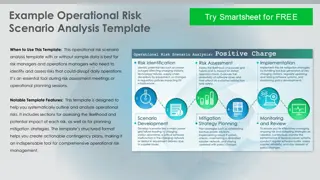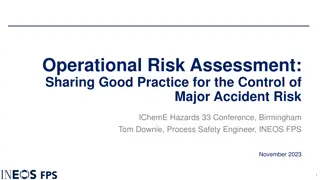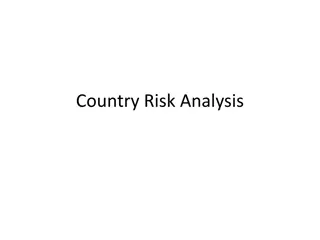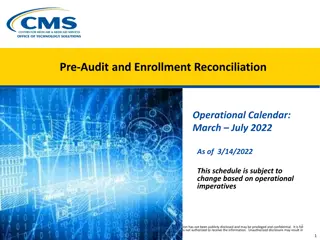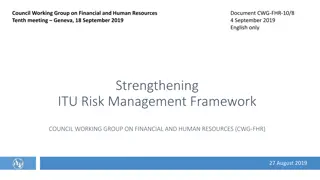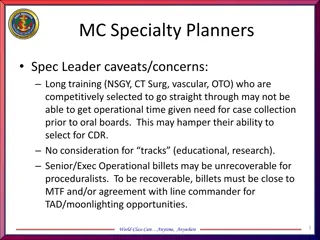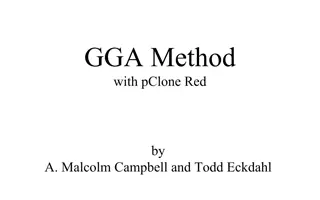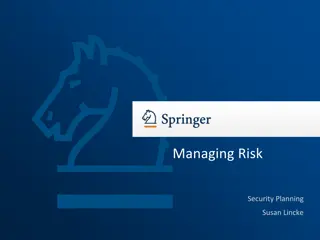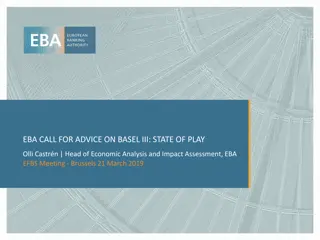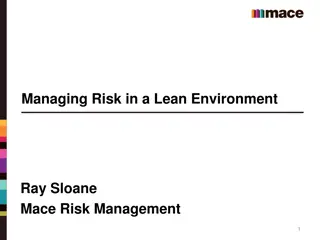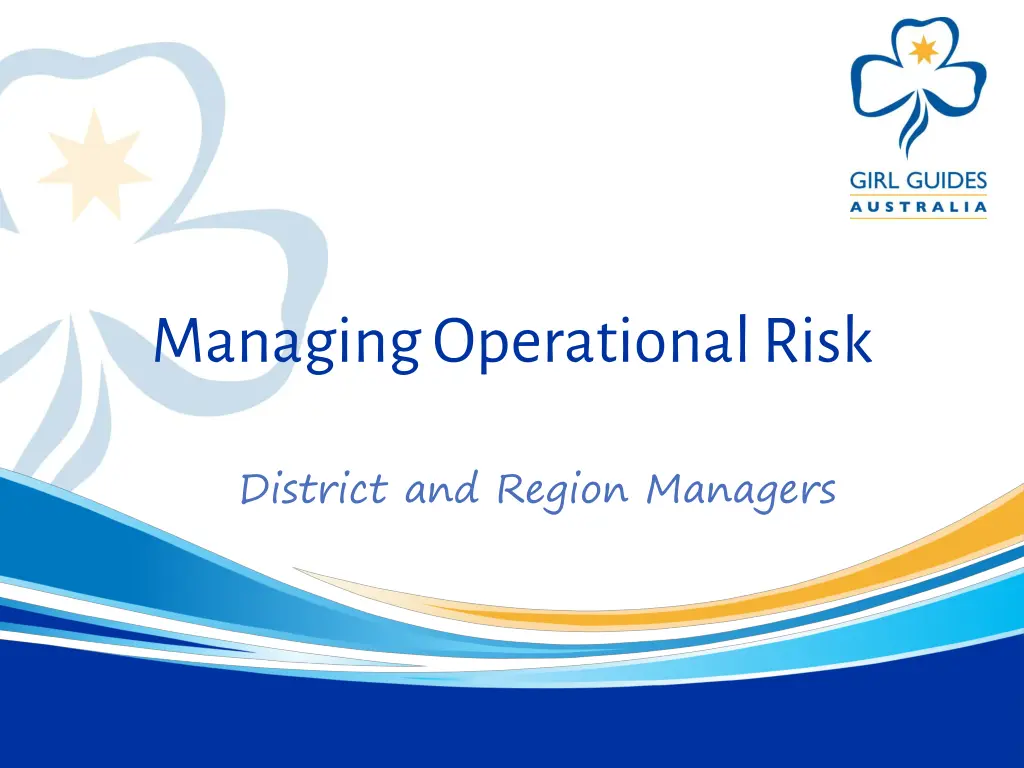
Effective Operational Risk Management for District and Region Managers
Learn about the importance of operational risk management for district and region managers in organizations like Girl Guiding in Australia. Discover the strategies, policies, and processes involved in identifying, assessing, and controlling risks to ensure a safe and sustainable environment for members and volunteers.
Download Presentation

Please find below an Image/Link to download the presentation.
The content on the website is provided AS IS for your information and personal use only. It may not be sold, licensed, or shared on other websites without obtaining consent from the author. If you encounter any issues during the download, it is possible that the publisher has removed the file from their server.
You are allowed to download the files provided on this website for personal or commercial use, subject to the condition that they are used lawfully. All files are the property of their respective owners.
The content on the website is provided AS IS for your information and personal use only. It may not be sold, licensed, or shared on other websites without obtaining consent from the author.
E N D
Presentation Transcript
Managing Operational Risk District and Region Managers
GGA Vision WHAT - We believe in delivering innovative, fun and relevant programs in a practical and safe environment. HOW- Our policy and processes for risk provide the ways for managing and reducing risks to support this vision
Risk Appetite Girl Guiding in Australia has an appetite to take reasonable risks. We are not risk averse We acknowledge that members and volunteers are accountable for their own behaviours, health and responsibilities within the Girl Guide organisation and to the community at large
Zero Tolerances GGA has zero tolerance of a limited number of matters including: We will not accept fatalities that are within our scope of influence We will not accept serious injury as a consequence of our negligence We will not accept bullying or any other poor behaviours that impact upon the well being of our members and volunteers.
Why do we manage Operational Risks? To keep us a viable and highly respected girl organisation For our own physical and psychological safety To grow competent Leaders and Managers in your District and Region For the safety of the girls To meet legal requirements of reasonable care (WHS Act 2011)
Region and District Managers Role Identify operational hazards Assess the effect that they will have on the Region or District - positive and negative Control the risk where needed
So what is Operational Risk Management? 1. A logic-based, common sense approach to making calculated decisions on people, reputation, and environmental factors 2. The process of identifying, assessing, and controlling risk Operational risk management is a way to manage risk and applies to everything we do.
Risk Management Properly understood risk management is an opportunity.
When would you complete an operational risk assessment? Annual health check When big decisions are being made When future planning is being done
4 Step Process (ORP) Identify, Assess, Control, Reassess Identify the hazard (GGA buckets) Assess the consequence and likelihood of the risk for the hazard Control the risk Reassess the risk and determine if it is acceptable
What are the main hazards to Regions and Districts? Safety Financial Unqualified Leaders Reputation Non approval for events Child protection Property Social Media Intellectual property
Risk Buckets 1. Governance Risk to reputation and risk to governing rules(legal liability) 2. Guiding (Activities of Guiding) Risk that activities are not appropriate to the philosophy, principles and method of Girl Guides Australia. Activities are planned that are not suitable and do not meet the developmental needs of the participants 3. People The physical, emotional, and psychological well-being of all members and participants is paramount to our beliefs. Includes all members (youth and adult), volunteers, parents, activity providers, general public, business associates.
Risk Buckets 4. Financial Financial consequence linked to cost of loss associated with risk 5. Guiding Operations (Business of Guiding) Day to day running i.e. unit leader consent forms not completed, activity notification forms not completed. Includes data integration, marketing, communications, compliance with business legislation, capacity and capability of units/districts/State offices to manage the business side of Guiding.
Step 1: Identify the Hazards Check incident reports Consult State Risk Representatives to see if others have similar problems Review plans for the coming year Use your experiences and that of other people Consult with managers in a similar position Inspect the meeting place Ask an expert Talk through possible hazards with others
Step 2: Assess the Initial Risk Consequences table Likelihood table Risk Analysis table
Likelihood Rating Table LIKELIHOOD DESCRIPTION The event is expected to occur in most circumstances. (At least 5 times a year) Almost Certain The event will probably occur in most circumstances. (Twice a year) Likely The event might (or could) occur at some time. (Once a year) Possible The event will probably not occur. (Once in 5 years) Unlikely Rare The event may only occur in exceptional circumstances.
Consequences Rating Table CONSEQUENCE Insignificant Minor Moderate Major Catastrophic
Consequences Rating Table CONSEQUENCE DESCRIPTION Low level Impact with negligible consequences on the aim or activity objectives that can be controlled by routine management procedures. Insignificant
Consequences Rating Table CONSEQUENCE DESCRIPTION The consequences would threaten the efficiency or effectiveness of achieving some aspects of GGA s aim or activity objectives, requiring management effort to minimise impact. Minor
Consequences Rating Table CONSEQUENCE DESCRIPTION A significant/medium potential of affecting the achievement of GGA s aim or activity objectives. Moderate
Consequences Rating Table CONSEQUENCE DESCRIPTION A very high potential to impair the achievement of GGA s aim or activity objectives. Major
Consequences Rating Table CONSEQUENCE DESCRIPTION An extreme potential to threaten the sustainability of GGA or its aims and activities. Catastrophic
Risk Analysis Matrix CONSEQUENCES what is the maximum reasonable consequence? LIKELIHOOD RATING Insignificant Minor Major Catastrophic Moderate Medium Medium High Extreme Extreme Almost Certain Low Medium Medium High Extreme Likely Low Low Medium High High Possible Low Low Low Medium High Unlikely Low Low Low Low Medium Rare
Step 4: Assess the residual risk Repeat Step 2 taking into consideration the controls that will be used Is the level of risk now acceptable?
Risk Priority Table RISK PRIORITY ACTION A n extreme risk is one that must be dealt with immediately. State/National Executive management normally monitors extreme risks. One (Extreme) A high risk is one that should be dealt with after attending to extreme level risks. Managers at Region/State normally monitor high risks. Two (High)
Risk Priority Table RISK PRIORITY ACTION A medium risk is one that can be dealt with by applying routine procedures and is normally dealt with by local Managers at the Region/District level. Three (Medium) Risks in the low category may be accepted but should be monitored periodically to ensure the rating does not change. Four (Low)
Make a plan Work out what actions need to be taken in order to implement the control measure. Allocate someone to be accountable for each action . For the Operational Risk Plan to be followed it needs to be shared.
Reporting and Recording Once you have completed your ORP send a copy to your Manager Distribute to your team Discuss with your team Use the Action Plan Monitor the implementation, and update as required (at least annually)
What do we have to support DMs and RMs? District, Region and/or State Team Learning Partner District Manager Region Manager State Risk Representatives
Where to from here? For those working on the Manager Qualification you will need to prepare or update the ORP for your Region or District as one of your Passport activities. All Managers should be updating their District or Region ORP on an annual basis as a health check .
Final Message By focussing on Operational Risks and planning for the future our members will grow into confident, self-respecting, responsible, community members.


